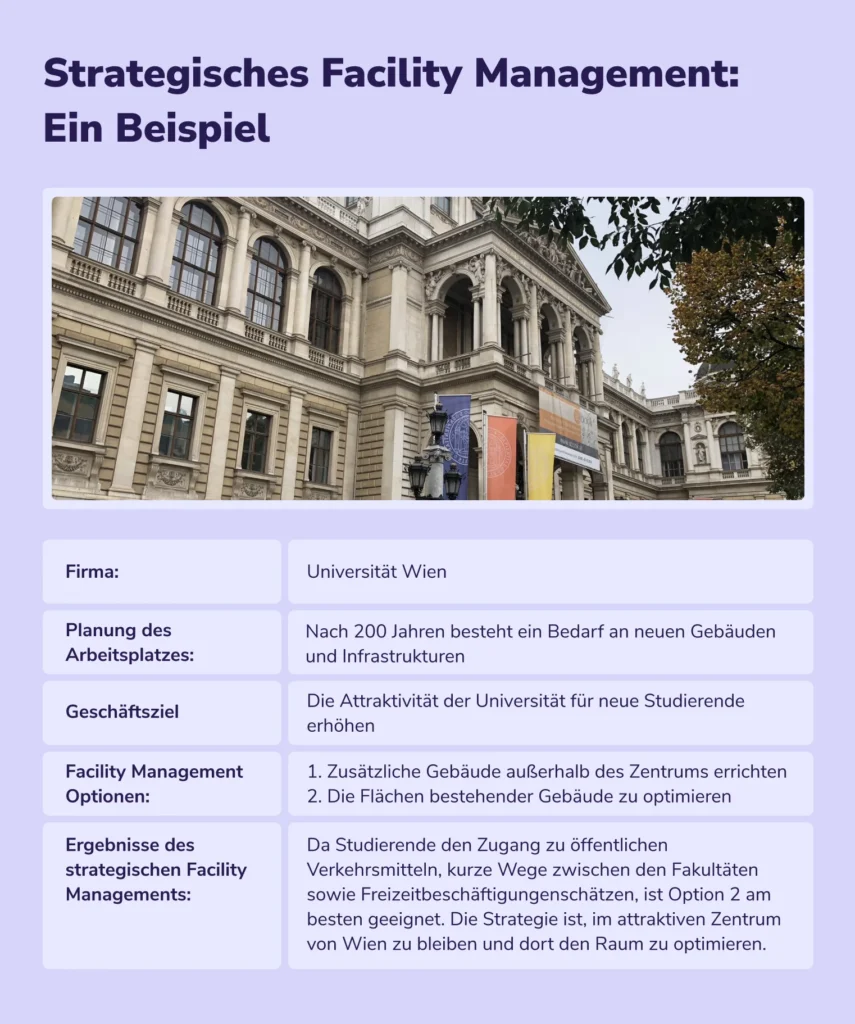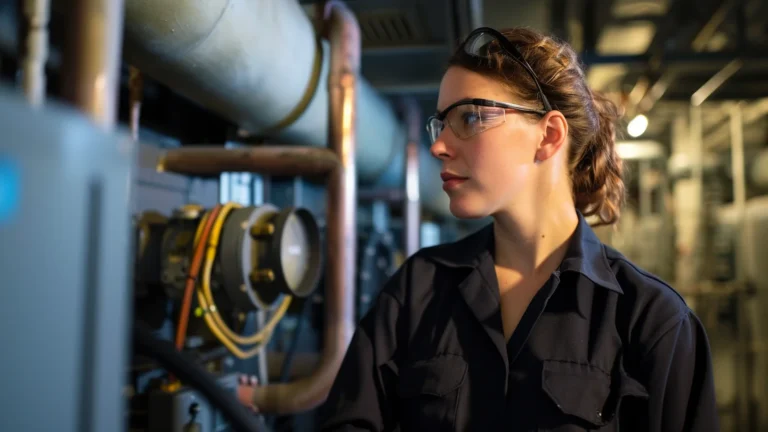Are you tired of dealing with the daily problems of maintaining your business premises? From water damage to electrical faults, facilities management can be a major challenge.
But what if there was a way for you to simplify these processes so that you could focus on growing your business again? Yes, with the right approach, you can turn your buildings and facilities from a source of stress and cost into a competitive advantage.
In this article, you will learn about all aspects of facilities management, such as the different departments, how to organize facilities management efficiently and all the important trends and developments that you should not miss.
What is facilities management?
Facilities management involves the coordination of people, machines and processes to ensure that buildings function properly.
What does facilities management mean?
In practice, facilities management means keeping buildings and their equipment in good condition and using them efficiently. Regardless of the industry, facilities management ensures that:
- the business remains in order
- the employees are safe
- productivity is increased
- the workplace remains friendly and inviting for employees and customers
For whom is facilities management worthwhile?
Basically, any organization that owns or leases a physical facilities or infrastructure can benefit from facilities management services. Facilities management is particularly important for office buildings, hospitals, schools, factories and airports, for example.
This includes both private and public organizations, from small businesses to large corporations and government agencies.
The most important facilities management departments

In facilities management, there are various departments that contribute significantly to the efficient organization and maintenance of buildings and facilities.
It is important that the facilities management departments complement each other ideally in order to ensure holistic support for properties and facilities.
Their joint work ensures that both the technical systems and the infrastructural services function optimally, thus guaranteeing the well-being and satisfaction of all employees and customers.
The classic facilities management departments can be divided into the following categories:
- Maintenance: The term maintenance refers to regular measures such as cleaning, inspections and minor repairs. Facilities management includes the development of maintenance plans and the monitoring of repairs and preventive maintenance tasks.
- Maintenance: The term servicing refers to more extensive repairs, such as the replacement of components or systems. Facilities Management also takes care of servicing management.
- Security and damage management: Facilities management includes the implementation of security measures such as cameras, access control systems and emergency plans. This keeps employees, visitors and customers safe and secure.
- Why is modern order management important for your company?
- Stakeholder management & fostering business relationships: Facilities management brings various stakeholders together. This includes managing expectations, resolving disputes and regular reporting on ongoing repairs and maintenance to the building. Facilities managers manage contracts, negotiate prices and ensure that suppliers comply with service level agreements.
- Space management: Efficient space management can give you an enormous competitive advantage. Facilities management ensures that the space within the facilities is used efficiently and effectively. This can include office planning, furniture and equipment arrangements as well as storage solutions.
- Energy and environmental management: Sustainability is an important topic worldwide. Modern facilities management therefore also means taking energy consumption and the environmental impact of buildings and facilities into account. This can include implementing energy efficient practices, reducing waste and managing the use of natural resources.
- Budgeting and financial management: Facilities management includes developing and managing budgets, tracking expenses and ensuring that costs are kept under control.
What is the difference between facilities management and building management?
In German, the terms facilities management and building management are often used interchangeably, which leads to confusion and misunderstandings. While both terms refer to the management, maintenance and repair of buildings and facilities, building management is only one part of facilities management.
Building management is only used during the operating phase of a property. It is usually divided into the following areas:
- Technical building management
- Infrastructural building management
- Commercial building management
- Space management
- How you can technical facilities management increase the functionality of your facilities
Building management ensures the integrity of the building itself and its direct installations. The tasks in building maintenance include, for example, the maintenance of elevator, sanitary, HVAC and electrical systems.
Facilities management, on the other hand, encompasses a broader range of activities and responsibilities. These relate to the productivity and goals of the company as well as the quality of life in the building.
In most cases, both key management and commercial cleaning as well as budgeting, workplace management, occupancy planning and project management are usually subsumed under the term facilities management.
What are the tasks of a facilities manager?
The facilities manager has a wide range of tasks and their influence can be seen at a strategic and operational level. A facilities manager has a multifaceted role that requires a high degree of responsibility and coordination skills.
He is a:
- Consultant
- Networker
- Organizational talent
- Leader
- Security expert
- Technical advisor
- Administrative expert
Although the tasks vary from company to company, the facilities manager is generally responsible for the maintenance and upkeep of an organization’s buildings.
The facilities manager ensures that these comply with legal requirements and health and safety standards. The main focus is on sustainability, resource and energy management.
Efficient facilities management

There are various methods for optimal facilities management that can bring additional benefits:
- Integrated facilities management increases efficiency and promotes cooperation between different service providers and stakeholders.
- Strategic facilities management aligns the activities of facilities management with the general strategic goals of an organization.
- Better workplace equipment makes employees more productive.
- Facilities management software enables considerable cost, time and labor savings.
Work more efficiently with integrated facilities management
Would you use multiple systems to accomplish a single task? No, and it should be no different for your facilities management.
The integrated facilities management approach consolidates all facilities management efforts under one team. A team that is integrated into the company and carries out the work together. In contrast to managing several service providers, you have a dedicated partner.
Facilities management software from Wowflow centralizes task and team management in one tool.
Wowflow supports cross-company collaboration and enables a functional and coordinated team, even if it consists of different service providers.
Bringing business goals closer with strategic facilities management
Through strategic facilities management, a company takes a less reactive approach to the operation of its workplace and instead focuses on long-term plans and initiatives. This is definitely an exciting option for optimizing facilities management.
Unfortunately, facilities management is usually underestimated at company level. The focus is usually on all other aspects of a company: financial planning, marketing, product and service development, employee recruiting etc.
- Employee retention in facilities management: this is how you can increase your company’s success
According to IFMA, between 10% and 18% of total expenditure is attributable to property and facility services.
Although a company does not own its buildings, it usually owns certain equipment and inventory that is required for its core business. This accounts for a large proportion of assets on the balance sheet and leads to high costs in the form of depreciation and amortization.
So why not make the workplace an asset as well?
This is achieved with strategic facilities management. Strategic facilities management links a business objective with the use and planning of the workplace.

High-quality equipment for productive employees
High-quality equipment, such as user-friendly software or high-quality desktop devices, can have a positive impact on employees’ work experience. Good equipment in the workplace contributes to greater employee commitment.
Interruptions due to IT errors or poor software selection can lead to a lack of motivation and productivity. The software should be organically integrated into the employees’ day-to-day work and tailored specifically to their needs.
The choice of suitable software is also a crucial investment. See if you can visualize all the programs your company uses. Most companies not only invest in bad software, they often don’t even use it.
According to data collected for the G2Track launch, unused software costs organisations $40 billion each year in overspending.
Find out about the numerous advantages of Wowflow over conventional CAFM software.
Advantages of facilities management software
More than ever, facilities management teams need to store accurate and available data, choose sustainable practices for their buildings and prioritize building effectiveness and efficiency.
Facilities management software makes the work of facilities managers more seamless and less error-prone. This in turn means that they spend less time on unnecessary tasks and can focus on their core business. Facilities management software also enables better data management, which leads to better decision-making and lower operating costs.
Service and maintenance modules provide users with functions for the integration of detailed maintenance plans for devices, machines and systems, for example. The software reminds you automatically and in good time of scheduled inspections and maintenance.
Numerous modules and software solutions for facilities management
There are different types of facilities management software – CAFM, CMMS, ERP, EAM and IWMS. Each system has different purposes and functions, but these can overlap. All of them are now standard in facilities management.
Facilities management software usually offers various modules, such as:
- Maintenance management
- Key management
- Maintenance management
- Order management (ticketing)
- Asset Management
- Personnel resource planning
- Functions for technical documentation
- Reporting options
- Communication functions
Implementing the right software solution for facilities management can be an absolute game changer for teams and companies.
Wowflow meets the needs of facilities management perfectly.
Hundreds of facilities management companies use Wowflow’s intuitive and clear software solutions for:
How does facilities management support companies?
The 7 biggest advantages
As a direct result of good facilities management practices, many benefits can be highlighted for a business, we have summarized the 7 most important benefits for your business.
- Improved efficiency and productivity
- Better compliance
- Cost savings and higher income
- Better customer experience
- Higher employee satisfaction
- Higher safety standards
- Fulfilling the sustainability criteria
Trends and developments in facilities management
Due to rapid technological progress, the facilities management industry is constantly evolving and a number of new trends will also come to the fore this year.
The trends reflect the development of the facilities manager’s role, so it is worth keeping an eye on them and gradually incorporating them into the facilities management strategy.
But how can you make informed decisions and invest in the right technology?
We take a closer look at the most important trends:
Facilities management: from reactive to proactive
Facilities management software and technologies enable a clear transition from reactivity to proactivity. By reducing unexpected incidents, system failures and safety risks, the focus can be placed on the core business and strategy development without interruption. Preventive maintenance management is becoming the core of facilities management thanks to monitoring tools and data analysis.
ESG reporting and sustainability

Nowadays, companies are obliged to fulfill ESG requirements and submit sustainability reports. To demonstrate its commitment to this goal, a company can use ESG reporting software, for example. This tool is a must for creating comprehensive reports on sustainable practices and performance.
"Mobile first" and paperless building operation
“Mobile first” building operation is becoming the standard, with a central app, a paperless approach and simpler communication with tenants. Wowflow offers an intuitive, mobile collaboration tool with the creation of image-based work orders and problem reports via QR codes.
Wowflow’s solution is specifically tailored to the needs of facilities management teams. Manage facilities management tasks and processes efficiently with Wowflow.
Maintenance 4.0 - on the way to an intelligent future
Facilities Maintenance 4.0 is a concept that involves the integration of advanced technologies such as the Internet of Things, artificial intelligence, machine learning and big data analysis to optimize the management and maintenance of facilities.
This approach enables facilities managers to collect and analyze large amounts of data in real time to make data-driven decisions and identify potential problems before they occur.
A further step towards increasing the reliability and efficiency of the building systems, reducing maintenance costs and improving the overall performance of the building.
- The key to controlling your resources: Mobile time tracking in facilities management
FAQ: Facilities Management
What is "hard" and "soft" facilities management?
Hard facilities management services relate directly to the building. They are inextricably linked to the building and are generally regarded as capital expenditure. Soft facilities management services primarily improve the well-being of the people in the facilities and enable them to make the most of their time in the facilities.
What is the difference between a facilities manager and a janitor?
The janitor is usually responsible for the day-to-day maintenance and cleaning of buildings and facilities, while the facilities manager has a broader responsibility and takes care of the strategic planning and management of buildings and facilities.
What do you need to become a facility manager?
The profession of facilities manager requires a technical education, such as in building technology, or a background in business administration, construction management, real estate management or energy management. In Germany, it is possible to study facilities management at universities of applied sciences or technical universities.



